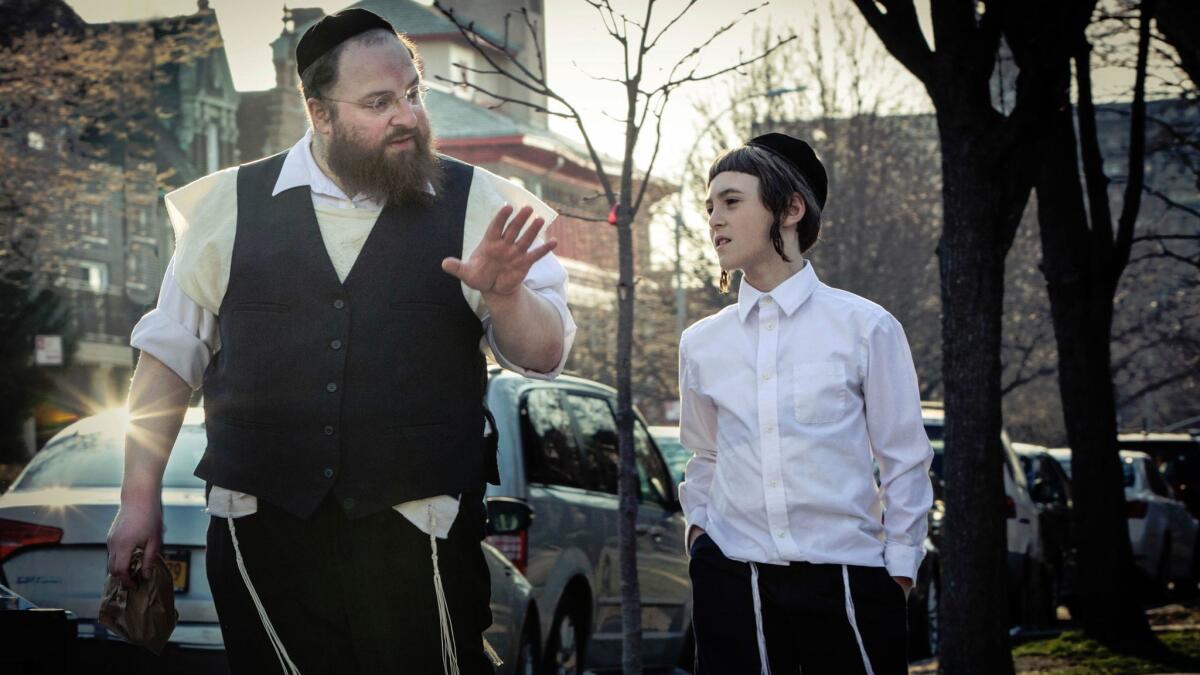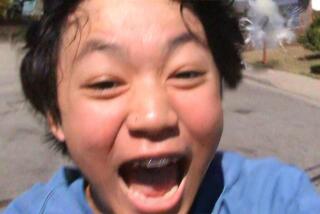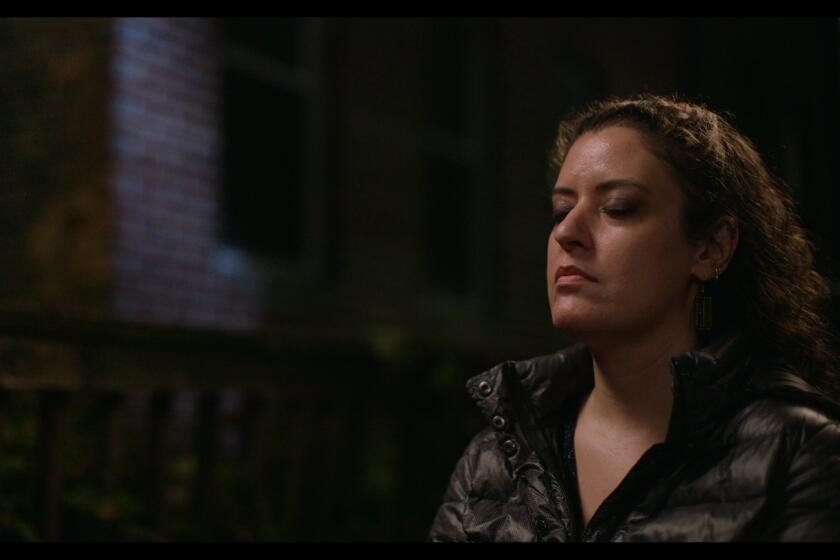How did a Sundance filmmaker shoot a scripted movie in the insulated world of New York’s Hasidim?

The secular filmmaker Joshua Weinstein stood on a helter-skelter corner in this ultra-Orthodox Jewish neighborhood next to shops selling conservative fashions and Internet-disabled smartphones, and pondered his recent guerrilla shoot.
“The strangest casting moment, let me think about that,” the director said, tilting back his head. “It might be all the times I sat through an hour of evening prayers because I happened to be talking to a potential actor and they needed a 10th man for a minyan [a prayer quorum]. Or maybe it was when I accompanied the rabbi to the mikveh [Jewish ritual bath].”
He paused thoughtfully. “It’s hard enough to cast your independent film when you’re not submerged without clothes in steamy waters.”
FULL COVERAGE: 2017 Sundance Film Festival »
Weinstein experienced a series of colorful moments to craft the low-key authenticity of “Menashe,” his heartfelt gem of a scripted drama that will premiere Monday at the Sundance Film Festival in the upstart Next section. At a time when television series such as “Breaking Amish” aim to shed light on cloistered religious communities, “Menashe” harbors similar goals in a fresh context: It seeks to get behind the veil of New York’s Hasidim, people generally depicted in pop culture as enigmatic props, when they’re even seen at all.
To make the all-Yiddish-language film, the director used the kind of shoe-leather techniques and subcultural curiosity that has given Sundance its unique reputation. Shot entirely on location and almost entirely with Hasidic (non)actors, “Menashe” represents a feat of logistical and conceptual prowess, telling a story about people in the very medium they’re skeptical of. Forget whether Weinstein’s actors had ever been in a professional movie — many of them had never even seen one.
“They made up with enthusiasm and authenticity,” Weinstein said dryly, “what they lacked in formal training.”
Inspired loosely by real events, Weinstein’s film tells of Menashe (Menashe Lustig), a schlumpy thirtysomething widower who can’t find peace either at his blue-collar supermarket job or in his personal life, where his brother-in-law (with the approval of the rabbi) has taken custody of Menashe’s pre-adolescent son. As they constantly tell him, a boy cannot be raised by a single father, and certainly not an underachieving one.
But though resisting remarriage for its own sake, Menashe deeply wishes to live and bond with his son — a goal that leads to a series of sweet, sometimes funny but often heartbreaking turns. “Menashe” is proof of that arts adage that one can achieve universality through specificity: While the Hasidic world that Weinstein portrays is arcane and exotic, the sentiments are instantly recognizable.
“I think a lot of movies about this world show the social problems. But all those problems are known. What I want to show is all the life, all the joy,” said Weinstein, 33. “Yes, being a Hasid can be about a certain seriousness and quiet. But there’s also a lot of fun and a lot of camaraderie, the kinds of things we all long for.”
While sometimes confused with other forms of ultra-Orthodoxy, Hasidism is a very particular strain of Judaism. It derives from an 18th-century grassroots moment that sought to make religion more accessible to the masses via music and a kind of spirituality of feeling over scholarship. Today, different groups — they include the outward-looking Chabad as well as the more insular Ger, Satmar and Skver — carry out those traditions with sect-specific garb, Yiddish-language usage, devotion to a particular rabbi, and an aggressive anti-modernity that can include skepticism of technology (let alone film acting).
Weinstein, who attended a Conservative Jewish day school in suburban New Jersey, knew little of these groups growing up. He makes his living as a cinematographer, often on far-flung documentaries. But as he walked through the Hasid-rich Brooklyn neighborhood of Borough Park earlier this week, he spoke of his inspiration for the movie. In 2014 he had just completed a series of difficult shoots involving subjects such as poor villages in India and end-of-life care in the U.S. A more humanist story, in his own backyard, seemed appealing.
Without even knowing what story he wanted to tell, he began hanging out in Borough Park, bringing his notepad to the streets, stores and synagogues of this bustling neighborhood, often wearing a large black yarmulke to blend in. (Thank God for hipster filmmaker beards.) He also connected with several members of different Hasidic communities who’d left but retained roots in it, and linked up with a Chabad-affiliated casting agent who could bridge two worlds.
Matters would soon go awry. Would-be performers would sign on and drop out, realizing that it wasn’t worth the fallout at their synagogue or children’s school. Even now, Weinstein has declined to reveal the names of nearly all the actors apart from Lustig, knowing they could face blowback from the tight-knit community.
Financing was tricky too — money came from sources in the larger Jewish community, but in dribs and drabs. Weinstein would shoot for a few days or weeks at a time, put down his camera, go back to his day job, raise money, and then return to production. (The film was shot over a period of nearly two years.)
Locations would also fall through, as some store owners would get cold feet, fearing negative communal publicity.
“That’s the supermarket we shot in,” Weinstein said, as he gestured to a large store on a major thoroughfare. “Well, one of them. We got kicked out of four supermarkets, I think. They all form one supermarket in the movie.”
Meanwhile, only a small percentage of the people who came in to read for parts had even seen movies — and even then they tend to be locally sourced “kosher” recordings, low-budget productions with spiritual messages. Some had honed their chops at so-called “Purim Spiels,” a kind of Hasidic Chitlin Circuit of seasonal skits centered on the springtime masquerade holiday. Still, those were big, broad comedies — not exactly useful for a lo-fi drama. Weinstein asked performers to enact stories or behaviors from their own lives, wrote scenes around them, then fit them into the script.
Key to the film was Lustig. A member of the Skver sect, the 38-year-old had stirred up minor celebrity — and controversy — in his community after posting a series of slapsticky home videos on YouTube. Weinstein met Lustig and was struck by his talent and back story. Lustig had moved to London when he married his wife, a Hasidic Brit, around 2000. His wife would die several years later, and Lustig returned to New York with his then-4-year-old son. Like the widower character he plays, a family member had sought to keep custody of his son. Weinstein heard the tale and built his movie around it. Then he convinced the Hasid to take a starring role.
“I don’t feel I’m being rebellious,” said Lustig, as he waited in the lobby at a pre-festival reception in Manhattan that evening, in his trademark beard and conservative garb. “I just think if someone has talent — if God gives you talent — because you’re a Jew you’re not allowed to use it? It doesn’t make sense.”
Lustig speaks with a mixture of sincerity, reasonableness, folk wisdom and jokiness, and he employed all these traits to explain how he came to take the part. “We say in Chasidut: More than the calf wants to drink, the mother cow wants to give. I feel I have to give.”
Lustig said the character is based on him — sort of. “Unlike Menashe in the film, I’m not a schlimazel by nature. Maybe just a schlimazel by situation.”
(One art-imitating life touch: Lustig himself also worked at a supermarket. At times during the shoot he would be getting yelled at in-scene by his supermarket manager--then, during breaks, took impatient calls from his real-life supermarket manager.)
Though most of the shots in “Menashe,” through the use of street-sign disclaimers, were at least nominally sanctioned, the film at Sundance may conjure associations to “Escape From Tomorrow,” the 2013 festival phenomenon that was shot on the sly at Disney theme parks. Like that film’s director, Weinstein would often stand far from the location so as not to attract attention, conveying direction to actors through earpieces.
Maybe chief among his difficulties was the language. Weinstein doesn’t speak Yiddish, so he had people translate the script. Then, during shooting, he’d have a bilingual production assistant read the actors’ lines to him, in English, via the earpiece.
As he climbed the stairs of an elevated train to show where he had shot a scene, Weinstein reflected on the unusual production.
“I think shooting a movie this way, you have to be OK with organized chaos,” he said. “Or with creating a lot of chaos to make everything seem like ordinary life.”
More to Read
Only good movies
Get the Indie Focus newsletter, Mark Olsen's weekly guide to the world of cinema.
You may occasionally receive promotional content from the Los Angeles Times.











